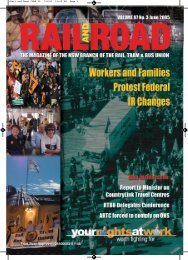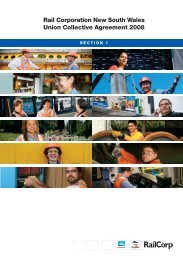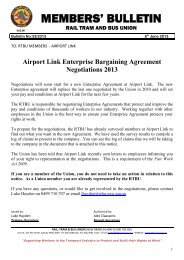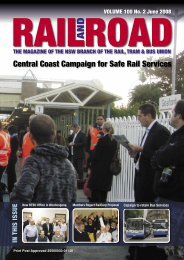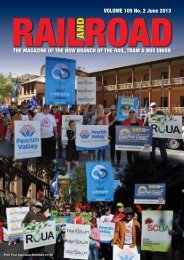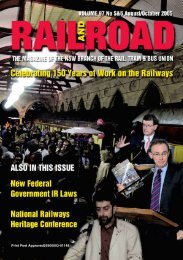Safety Matters - Rail, Tram and Bus Union of NSW
Safety Matters - Rail, Tram and Bus Union of NSW
Safety Matters - Rail, Tram and Bus Union of NSW
You also want an ePaper? Increase the reach of your titles
YUMPU automatically turns print PDFs into web optimized ePapers that Google loves.
Operators have a responsibility to establish <strong>and</strong> maintain working conditions<br />
that allow:<br />
(a) <strong>Rail</strong>way employees sufficient opportunity to obtain adequate rest between<br />
shifts, <strong>and</strong><br />
(b) Alertness to be sustained throughout their period <strong>of</strong> duty.<br />
Operators must place a duty on railway employees to report for work rested<br />
<strong>and</strong> fit for duty.<br />
Fatigue management programs<br />
Fatigue management programs should aim to achieve the following:<br />
(a) Reduce fatigue <strong>and</strong> improve the on-duty alertness <strong>of</strong> railway employees,<br />
<strong>and</strong><br />
(b) Reflect the nature <strong>of</strong> the operations conducted by the operator including<br />
operating conditions.<br />
Operators shall ensure that railway employees <strong>and</strong> their designated<br />
representatives are consulted in the development <strong>and</strong> implementation <strong>of</strong> fatigue<br />
management programs, including the making <strong>of</strong> changes to such programs.<br />
Fatigue management programs shall consider, but not be limited to, the<br />
following:<br />
(a) The risks associated with the particular form <strong>of</strong> railway safety work,<br />
(b) <strong>Rail</strong>way employee work scheduling practices, including relief arrangements<br />
to cover absences,<br />
(c) Physiological factors <strong>of</strong> railway employees,<br />
(d) Education <strong>and</strong> training,<br />
(e) On-the-job alertness strategies,<br />
(f) Rest environments provided by the employer (eg. sleeping facilities located<br />
aboard a locomotive or in a depot),<br />
(g) Work environments,<br />
(h) Working under unusual, unpredictable or emergency operating conditions,<br />
(i) Variations in shift <strong>and</strong> rest scheduling required by different routes,<br />
(ii) Scheduling <strong>of</strong> shift <strong>and</strong> rest periods.<br />
<strong>Safety</strong> <strong>Matters</strong> A Guide for Workplace OHS Representatives<br />
SECTION FOUR<br />
RAIL<br />
TRAM AND BUS<br />
63<br />
OHS Factsheets<br />
U N<br />
I O N





